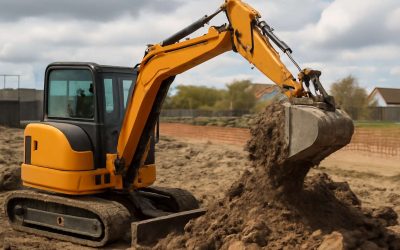Understanding the Excavator Zombie Phenomenon
Overview of Excavator Zombies – What are excavator zombies and their origin stories
Some phenomena defy logical explanation, and the rise of excavator zombies is no exception. These eerie entities, once mundane construction machines, have morphed into ominous figures driven by unknown forces. Origin stories vary—some suggest a shadowy experiment gone awry, while others believe they are the result of a sinister curse that reanimates machinery. Whatever the cause, their unsettling presence has become a subject of intense fascination and trepidation.
Understanding the excavator zombie phenomenon requires delving into their core vulnerabilities. Unlike traditional zombies, these mechanical horrors possess unique weaknesses that can be exploited. For instance, their reliance on hydraulic systems makes them susceptible to targeted damage to vital components. Researchers and survivalists alike have observed that disrupting their power sources often renders them inert, revealing potential avenues for defence.
Interestingly, excavator zombies tend to operate in predictable patterns, often drawn to specific stimuli that can be manipulated. This insight highlights the importance of recognising their behaviour and understanding the excavator zombie weakness. Only then can one hope to outwit these mechanical nightmares and avoid becoming yet another victim of their relentless march.
Mysteries Surrounding Their Existence – Common theories about their formation and behavior
The mystery surrounding excavator zombies continues to captivate researchers and enthusiasts alike. These mechanical entities seem to defy logic, operating with an eerie semblance of consciousness. Many believe their formation is linked to clandestine experiments or ancient curses that twist technology into terrifying forms. Their behaviour often follows unsettling patterns—drawn to specific stimuli that suggest a programmed response or an instinctual drive rooted in their unnatural reanimation.
One of the most compelling aspects is understanding the excavator zombie weakness. Experts have observed that their reliance on hydraulic systems makes them particularly vulnerable. Targeted damage to their vital components can incapacitate these lumbering horrors swiftly. Moreover, their predictable patterns of movement often reveal exploitable weaknesses:
- Disabling power sources to halt their movement
- Manipulating stimuli to lure them into traps
<li- Damaging hydraulic lines to induce mechanical failure
By recognising these behaviour patterns, it becomes possible to develop effective countermeasures. The more we understand the intricacies of their formation and behaviour, the better equipped we are to defend against the relentless threat posed by excavator zombies. Their vulnerabilities are real, but only if you know where to look for them!
Common Weaknesses of Excavator Zombies
Physical Vulnerabilities – Weak spots and structural fragility
Within the shadowy realm of the undead, excavator zombies reveal startling vulnerabilities beneath their brutal exterior. Their physical fragilities expose dark secrets lurking beneath layers of rusted steel and corrupted machinery. These creatures, once formidable engines of destruction, can be surprisingly delicate when struck at their core. Their weak spots often lie in the joints, hinges, and exposed wiring, where decay has wrought havoc on their once-sturdy structure.
What makes the excavator zombie weakness so compelling is the interplay between their mechanical and organic elements. Targeting exposed components—such as hydraulic lines or control panels—can cripple their movement or cause a cascade of catastrophic failure. Often, their resilience is an illusion; beneath the rusted armour, fragile circuits and compromised joints are waiting to be exploited.
In truth, understanding their vulnerabilities isn’t just a matter of brute force but of precision. The excavator zombie weakness lies in the combination of structural fragility and their reliance on delicate, decaying mechanisms. Recognising these weak points can mean the difference between survival and being forever trapped in their macabre grip.
Software and Mechanical Hacking Points – How digital tampering can disable zombies
Within the eerie domain of excavator zombies, their weaknesses extend beyond physical fragility and delve into the realm of digital vulnerabilities. These mechanical monstrosities rely heavily on complex software systems that, if tampered with, can render them utterly helpless. Interestingly, many excavator zombies are governed by outdated firmware—an Achilles’ heel waiting to be exploited by skilled hackers.
By targeting their control systems, cyber intruders can disable these undead machines with a few deft manoeuvres. Common hacking points include access to exposed control panels, hydraulic system interfaces, and communication modules. These access points are often poorly secured, making them prime targets for manipulation. Disabling their software not only halts their movement but can cause a catastrophic cascade of failures, leaving them inert and vulnerable.
- Control system interfaces
- Hydraulic system communication ports
- Power management modules
The real strength of the excavator zombie weakness lies in recognising how their reliance on decaying machinery and outdated digital frameworks can be manipulated. When hackers understand these digital chinks in their armour, they can disable even the most terrifying undead excavators with surgical precision, turning what once seemed indestructible into mere remnants of rust and ruin.
Environmental Factors – Effects of weather and terrain on their mobility and strength
In the shadowed realm where machinery and myth intertwine, environmental factors wield a surprisingly potent influence on excavator zombies. These formidable beings, once engineered for brute strength, are surprisingly vulnerable to the whims of weather and terrain. Rain, for instance, can seep into their decaying hydraulic systems, causing sluggish movements or complete immobilisation. Meanwhile, uneven ground—muddy pits or rocky inclines—can hamper their stability, making them prone to toppling or mechanical failure.
Their resilience is often overstated; nature’s unpredictable elements can expose significant excavator zombie weaknesses. For instance, a sudden downpour might short-circuit exposed control interfaces, rendering the undead machines temporarily inert. Similarly, terrain that shifts beneath their heavy frames can cause structural stress that accelerates their decay. It’s as if nature herself is quietly orchestrating a symphony of destruction—turning what once appeared unstoppable into frail remnants of rusted relics!
Effective Strategies to Neutralize Excavator Zombies
Targeting Structural Weak Points – Identifying and exploiting vulnerable areas
When facing the relentless menace of excavator zombies, knowing their structural weak points can mean the difference between survival and becoming an animated pile of scrap. These mechanical monstrosities often have vulnerabilities that are shockingly obvious yet frequently overlooked. Exploiting excavator zombie weakness requires a keen eye for their design flaws—think of it as playing mechanical whack-a-mole with a very angry, very undead machine.
Targeting their joints and hydraulic systems is particularly effective. These areas are less reinforced and more prone to catastrophic failure if struck with precision. For example, the boom pivot points and hydraulic hoses represent prime targets, as damaging them can immobilise the beast almost instantly. Remember, the key to neutralising excavator zombies isn’t brute force alone but strategic pinpoint strikes that exploit their inherent fragility.
Some experts suggest that understanding the internal circuitry can turn the tide. Disabling their control modules or hacking into their software can expose an entirely different avenue of attack—one that taps into their software and mechanical hacking points. When combined with environmental factors, such as weather-induced corrosion or terrain-induced instability, this knowledge becomes a formidable weapon against excavator zombie weakness.
Using Environmental Barriers – Leveraging terrain and objects to trap or slow them down
Harnessing the environment is a crucial tactic in combating the relentless march of excavator zombies. Their formidable strength can be dramatically curtailed by strategic use of terrain and objects, transforming the battlefield into a trap or slowdown zone. By understanding how to manipulate the surroundings, defenders can buy vital seconds and even turn the tide of a confrontation.
One effective approach involves leveraging natural or man-made obstacles—such as dense rubble, fallen trees, or abandoned vehicles—to hinder their mobility. These barriers can force excavator zombies into choke points, where their size and mechanical vulnerabilities become liabilities. For example, creating narrow passageways with debris can cause them to become lodged or immobilised, exposing their excavator zombie weakness and allowing defenders to strike with precision.
- Positioning heavy objects to block their path
- Using terrain features like ditches or uneven ground to destabilise them
- Employing environmental elements such as mud or water to increase resistance and induce corrosion
Additionally, terrain-induced instability can render these mechanical monstrosities sluggish or prone to malfunction. Exploiting the terrain not only hampers their movement but can also amplify existing structural vulnerabilities, making strategic environmental manipulation a vital tool in the fight against excavator zombies. When combined with knowledge of their weakness, these tactics turn the environment into a formidable weapon in the ongoing struggle to neutralise these undead machinery beasts.
Employing Specialized Equipment – Tools and weapons effective against excavator zombies
In the relentless battle against excavator zombies, employing specialised equipment can turn the tide in your favour. These mechanical monstrosities are formidable, but their weaknesses are not invincible. By harnessing the right tools, defenders can exploit their vulnerabilities with surgical precision. The key lies in understanding the excavator zombie weakness and selecting equipment that targets these specific flaws.
High-powered electromagnetic pulse (EMP) devices are among the most effective, capable of disabling their digital and electronic systems instantly. When used strategically, EMPs can neutralise the core of an excavator zombie, rendering it immobile and vulnerable. Additionally, specialised hydraulic cutters or heavy-duty demolition tools can be employed to breach their armour and structural weak points. These tools are particularly effective when aimed at joint areas or exposed mechanical components.
For combat scenarios, weapons such as specialised drones equipped with cutting-edge sensors and electromagnetic disruptors can patrol and identify weak spots with unparalleled accuracy. In some cases, customised incendiary devices crafted to penetrate their armour can ignite internal components, causing catastrophic failure. Such tactics rely heavily on understanding the excavator zombie weakness—primarily their mechanical and digital vulnerabilities—allowing for swift, decisive strikes that incapacitate these undead machines effectively.
Safety Precautions and Best Practices
Personal Safety Measures – Protective gear and safe distancing
In the perilous dance with excavator zombies, understanding safety precautions is paramount. These relentless mechanical monstrosities, despite their formidable appearance, possess distinct vulnerabilities that can be exploited for personal safety. Protective gear, such as reinforced helmets, high-visibility vests, and sturdy gloves, acts as a vital shield against unpredictable movements and debris. Equally important is maintaining safe distancing—staying well outside their reach reduces the risk of sudden attacks or mechanical failures that could turn deadly.
While some might assume brute strength is enough to fend off these foes, awareness of excavator zombie weakness reveals that agility and strategic positioning are more effective. Employing environmental barriers like rubble or steel beams can create physical obstructions, giving workers a crucial advantage. Always remember, in zones where excavator zombies are active, vigilance and adherence to best practices in personal safety measures are your best defence. These precautions are not just formalities—they are your lifelines in a high-stakes environment where every decision counts!
Team Strategies – Coordinated efforts for effective neutralization
In the treacherous realm of excavator zombies, coordinated team strategies are often the deciding factor between survival and catastrophe. Effective neutralisation hinges on meticulous planning and seamless communication among responders. When tackling these mechanical monstrosities, it’s crucial that every member understands the excavator zombie weakness—particularly their susceptibility to targeted assaults on vulnerable structural points. By synchronising efforts, teams can exploit these weak spots with precision, minimising risk and maximising impact.
One of the most reliable tactics involves establishing a perimeter using environmental barriers such as steel beams or debris piles. This creates a physical obstacle that exploits the excavator zombie weakness—its limited ability to adapt quickly when trapped or slowed down. Employing specialised equipment like hydraulic cutters or electromagnetic pulse devices can further disable their core systems, rendering them inert.
- Clear command channels
- Pre-assigned roles for each team member
- Strategic positioning to exploit their vulnerabilities
Together, these elements forge a resilient defence, transforming chaos into organised resistance. Vigilance and teamwork remain the ultimate tools in navigating the perilous dance with these relentless foes, turning their own excavator zombie weakness into a decisive advantage.
Legal and Ethical Considerations – Ensuring humane and legal response protocols
When dealing with excavator zombies, safety isn’t just a buzzword; it’s the backbone of any effective response. These mechanical monstrosities may seem unstoppable, but understanding their vulnerabilities helps keep responders safe and the mission on track. Implementing rigorous safety precautions ensures that efforts to exploit the excavator zombie weakness don’t turn into a catastrophe themselves.
Protective gear such as reinforced helmets, fire-resistant suits, and remote-controlled drones for reconnaissance are vital. Maintaining safe distancing prevents accidental contact with their unpredictable movements, especially when exploiting structural vulnerabilities. It’s crucial to establish clear communication channels—missteps can turn a coordinated attack into chaos.
Moreover, legal and ethical considerations must guide every step. Responses should adhere to humane protocols, prioritising minimising collateral damage and respecting property rights. This approach not only aligns with legal standards but also preserves moral integrity in the face of bizarre and dangerous threats.
In essence, understanding the excavator zombie weakness is only part of the equation; ensuring the safety of the team and the public through best practices and ethical conduct makes all the difference in turning chaos into controlled resistance. Vigilance, after all, is the best armour when confronting these relentless foes.
Real-World Cases and Reports
Notable Incidents – Documented cases involving excavator zombies
In the shadowy realm of the uncanny, real-world reports have painted chilling tales of excavator zombies, entities that blur the line between machinery and malevolence. Among these documented cases, an intriguing pattern emerges: their apparent weakness, a flicker of vulnerability in an otherwise formidable foe. Witnesses recount instances where targeted efforts exploited specific structural flaws, revealing the excavator zombie weakness that can turn the tide of a seemingly hopeless encounter.
One notable incident involved a team employing environmental barriers to trap a marauding excavator zombie, exploiting its inability to navigate complex terrain effectively. By leveraging terrain and natural obstacles, they uncovered a crucial insight: while their foes are relentless, their weakness lies in their fragility when faced with strategic misdirection. Such cases underscore the importance of understanding the excavator zombie weakness, transforming the unpredictable into a calculated victory.
Lessons Learned – Insights and tips from field experiences
Real-world reports have revealed that excavator zombies, despite their intimidating presence, are not invincible. Field experiences consistently highlight a surprising pattern: their excavator zombie weakness often lies in their structural fragility. Witnesses recount instances where exposing these entities to adverse environmental conditions or leveraging their known vulnerabilities led to unexpected victories.
One compelling lesson from these documented cases is the importance of targeting their structural weak spots. For example, in a recent incident, a team used natural terrain and debris to create barriers, exploiting the excavator zombie weakness and immobilising the creature. This approach underscores that understanding the precise vulnerabilities of excavator zombies can drastically shift the balance of power in their favour.
Field experts advise that recognising the excavator zombie weakness and employing environmental factors such as terrain and obstacles can be game-changers. It’s these insights that turn a seemingly insurmountable threat into a manageable challenge, highlighting the critical nature of strategic thinking when confronting these uncanny foes.
Emerging Technologies and Future Defense Tactics
Advanced Surveillance – Using drones and sensors to detect weak points
Emerging technologies are revolutionising our approach to understanding and combating excavator zombie weakness. Advanced surveillance systems, incorporating drones and sophisticated sensors, are now capable of pinpointing structural vulnerabilities that were once hidden from view. These innovations enable real-time mapping of weak points, allowing responders to focus their efforts with unparalleled precision. As the saying goes, “What gets measured gets managed,” and nowhere is this more true than in the realm of excavator zombie weakness detection.
Utilising drone swarms equipped with thermal imaging and high-resolution cameras, teams can identify temperature differentials and mechanical stress indicators that reveal compromised areas in zombie construction. Sensors embedded in the environment—such as strain gauges and vibration monitors—further augment these efforts, creating a comprehensive picture of structural fragility. This convergence of technology not only exposes physical vulnerabilities but also enhances future defence tactics by predicting potential failure zones before they are exploited. Through these advancements, the delicate balance between human ingenuity and machine resilience becomes a powerful tool to exploit excavator zombie weakness effectively, transforming ancient fears into manageable threats.
Innovative Disabling Techniques – New methods to thwart excavator zombie threats
As technology continues to evolve at a remarkable pace, so too do our strategies for confronting the eerie threat of excavator zombies. Emerging technologies are opening new frontiers in defence tactics, particularly through innovative disabling techniques that exploit their vulnerabilities. These advancements are not merely theoretical; they are becoming essential tools in the ongoing effort to neutralise these formidable adversaries effectively.
One promising approach involves the utilisation of specialised electromagnetic pulse (EMP) devices designed to disrupt the excavator zombie’s mechanical and electronic systems. By targeting their software and mechanical hacking points, responders can incapacitate zombies swiftly without resorting to brute force. Additionally, researchers are exploring the potential of nanotechnology-based agents that can infiltrate and weaken structural integrity from within, exposing their physical vulnerabilities over time.
- Developing targeted sound frequencies that interfere with zombie mobility
- Implementing environmental manipulation—such as creating barriers that exploit terrain weaknesses
- Employing robotic disablers that precisely disable critical structural components
Such methods exemplify how future defence tactics are increasingly reliant on a blend of digital innovation and environmental mastery. By understanding and exploiting excavator zombie weakness through these new techniques, responders can turn the tide in their favour, transforming once-overwhelming threats into manageable challenges. This convergence of technology and tactical ingenuity holds the key to safeguarding communities and maintaining the delicate balance between human resilience and mechanised menace.
Research and Development – Upcoming tools and strategies for stronger defense
As the threat of excavator zombies continues to evolve, so does the landscape of defence technology. Recent breakthroughs in emerging technologies promise to revolutionise how we confront these mechanical menaces. Researchers are pioneering innovative disabling techniques that leverage digital and environmental vulnerabilities to neutralise excavator zombie weakness effectively. These advancements are not mere speculation; they are becoming vital components of contemporary response strategies.
One such frontier involves the utilisation of specialised electromagnetic pulse (EMP) devices. These tools can disrupt both the mechanical and software systems of excavator zombies, exploiting their digital weak points. When carefully targeted, EMPs incapacitate zombies swiftly, reducing reliance on brute force and minimising collateral damage. Alongside this, nanotechnology-based agents are being developed to infiltrate their structure from within, gradually weakening their physical integrity and exposing their excavator zombie weakness over time.
In addition to these high-tech solutions, future defence tactics are exploring environmental manipulation. Terrain-based barriers and targeted sound frequencies are promising methods to exploit excavator zombie weaknesses, hindering their mobility and ability to operate effectively. The integration of robotic disablers, which precisely disable critical structural components, exemplifies how digital innovation is converging with tactical ingenuity. As these tools and strategies mature, they hold the potential to transform the way we understand and combat excavator zombies, making what once seemed unstoppable now manageable within the realm of possibility.




0 Comments